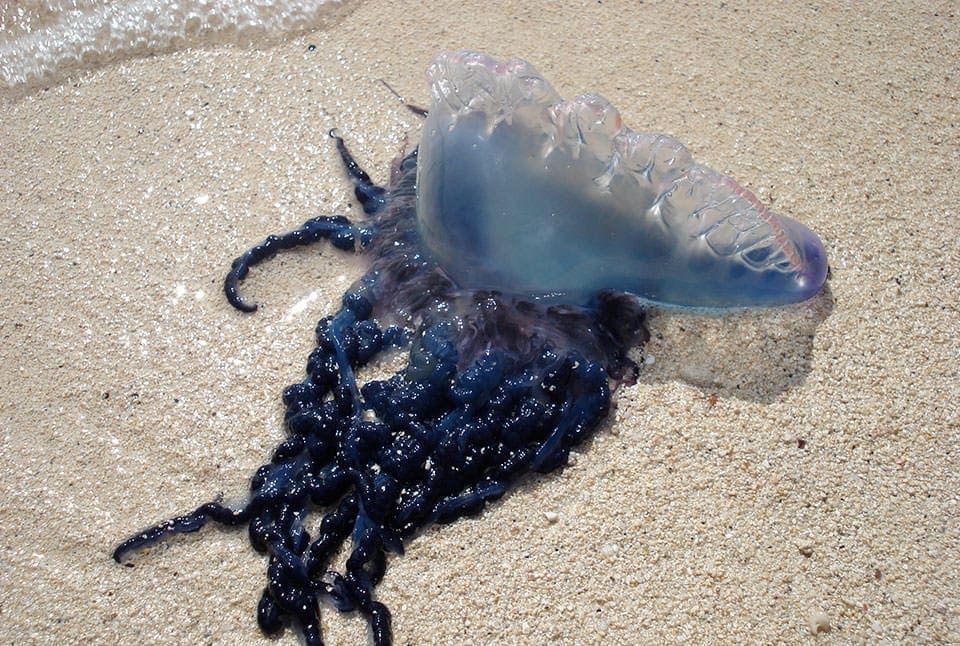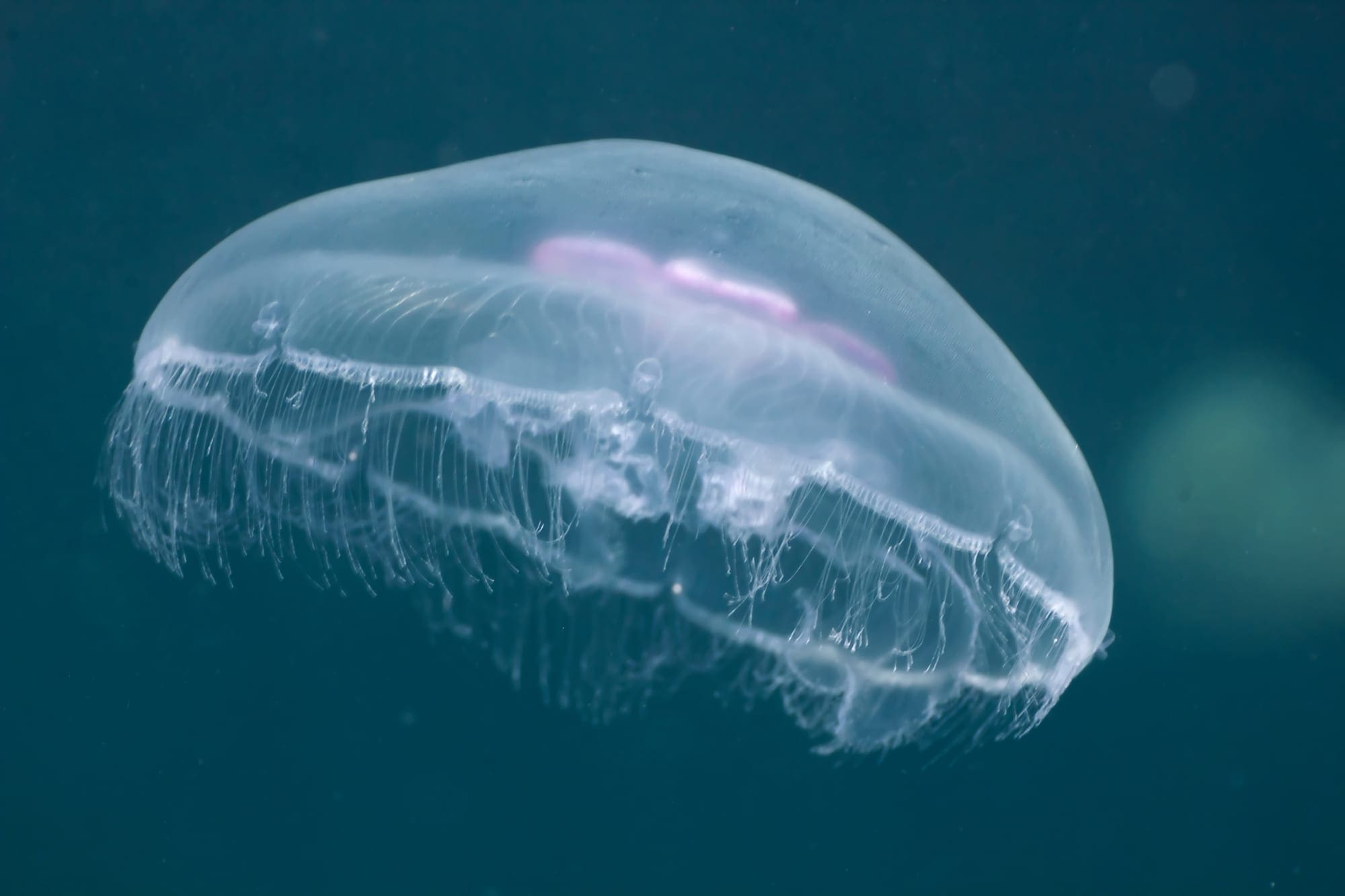The most common uncomfortable animal encounters on our beaches are those with jellyfish on the Gulf Coast. These beautiful creatures can sure put a hurtin’ on an unsuspecting swimmer. Generally speaking, they are made of three main parts: the bell, the oral arms and the tentacles. The tentacles hang from under the bells, waiting to find prey. Unfortunately, they also accidently find humans at times. True jellyfish can respond to light, smell, salt content in water and currents.
Jellies have an unusual sex life. They produce both the female eggs and the male sperm from the same creature. Baby jellyfish are produced after the cells are released directly into the water.
Jellyfish are related to sea anemones, sea whips, and corals. Frequently, siphonophores and chondrophores are mistaken for jellies. Actually, these are colonies of different animals that each have different roles in their tiny communities. They look like jellies and also have stinging cells.
Jelly Encounters
Frequently, a beach visitor will encounter jellyfish. You’ll find them either in the water or washed up on the sand. Most have a mild sting or none at all but some are best avoided.
The Nicer Guys
- Moon Jellies – Overall, these are the most common jellies seen on our beaches. They have short tentacles on the edges of their bells with stinging cells. They have a pink 4 leaf clover shape inside their bell. The stingers typically cause only mild irritation when touched. Local children enjoy poking at the top of the bell, knowing this is a safe part of the animal to play with.
- Atlantic Sea Nettle – These animals have long tentacles and oral arms. Interestingly, they change color depending on the saltiness of the water. In fresher water they may be clear or white. In saltier waters like the Gulf of Mexico they have red or brown streaks from the center of their bells.
- Cannonball aka Cabbage Head – A sea turtle’s favorite snack! They look like round balls with short oral arms and no tentacles. Their sting is very mild.
- Upside-Down jellies aka Cassiopeas – These cute little guys have a mild sting. They usually hang out on the sea floor and look like brown flowers.
- Sea lice – No relation to head lice. These are jellyfish larva floating around in the water that can also sting.
The Bad Guys
- Pink Meanie – This is a newly discovered species of jellyfish in the Gulf of Mexico. They eat other jellies, especially moon jellyfish. Their tentacles can be up to 70 feet long and weigh 50 pounds. Even though its sting isn’t as bad as a Man-O-War or Box jelly it is called a meanie for good reason.
- Box – These jellies are not to be messed with. They are square and only about 5.5 inches tall. They have pink outer tentacles and yellow inner tentacles that can be up to 13 feet long. Their sting can cause intense pain, heart and breathing problems. The rash they cause can last for several months. Fortunately, there is antivenom for their sting if needed.
Jellyfish Impersonators
- Comb jellies – These football shaped creatures glow greenish-blue in the water when disturbed. Their best feature is that they don’t sting!
- Blue-button – This chondrophore is a pretty blue round colony. Usually they don’t have a sting but they can cause irritation when touched. They float along with the winds and currents.
- By-The-Wind Sailor – This colony is also a small lovely blue sail. They can cause irritation when touched but their sting is usually mild. The direction of the sail determines which way they will be blown by the wind.
- Portuguese Man-O-War – This siphonophore is a nasty guy. It has up to 30 foot long tentacles that cause an extremely painful sting. They are easy to pick out by their beautiful purple-blue sail. Be sure to stay well away, both on land and in the water.
Jellyfish First Aid
First, prevent encounters with jellyfish if possible. Look for the purple Dangerous Marine Life flag on the beach. When in doubt, avoid touching any jellyfish or jellyfish pieces on the beach or in the water.
Second, identity if the jellyfish is of the stinging sort. Many jellies do not have a bad sting. Remember, stinging jellyfish can still sting if they are dead or in pieces. Again, when in doubt avoid touching jellies or their pieces.
Ouch! You found a jelly! Use sand to scrub the stinging cells off the skin. Hold the affected body part in hot water (NOT SCALDING). Though a shower or sink is ideal, exhaust water from a running boat engine is a fair substitute (NOT IN GEAR). Meat tenderizer or urine can also break down the stinging cells. Yes, urine. This is another good reason to stay hydrated at the beach. Aloe vera, vitamin E, hydrocortisone cream, ibuprofen, acetaminophen, and diphenhydramine can help with the symptoms. The rash from a sting can last for 1-4 weeks.
FOR SEVERE REACTIONS CALL 911. Fast emergency help may be needed for reactions that affect the victim’s heart or breathing. Don’t waste any time!
Further Reading
Check out these websites for more information about our Gulf Coast jellyfish. Thanks to all of them for aiding in my research!
Sanibel Sea School’s Five Types of Jellyfish in the Gulf of Mexico:
https://www.sanibelseaschool.org/experience-blog/2014/9/24/5-types-of-jellies-in-the-gulf-of-mexico
30A’s Five Common Types of Jellyfish Found in the Gulf of Mexico:
https://30a.com/five-types-of-jellyfish-gulf-of-mexico
Wikipedia’s Chiropsalmus quadrumanus:
https://en.wikipedia.org/wiki/Chiropsalmus_quadrumanus
National Oceanic and Atmospheric Administration’s What are jellyfish made of?: https://oceanservice.noaa.gov/facts/jellyfish.html
National Oceanic and Atmospheric Administration’s What Are Jellyfish?:
https://floridakeys.noaa.gov/animals/commonkeysjellies.html
Beachhunter.net: https://www.beachhunter.net/thingstoknow/jellyfish/index.htm
Panama City News Herald’s 7 ‘Jellyfish” found in Panama City Beach: https://www.newsherald.com/photogallery/DA/20190508/NEWS/508009996/PH/1
University of Florida Extension’s Embrace the Gulf 2020 – The Jellyfish: https://nwdistrict.ifas.ufl.edu/nat/2020/04/17/embrace-the-gulf-2020-the-jellyfish
30A’s Seven Astounding Facts About the Blue Button Jellyfish: https://30a.com/blue-button-facts
Check out our Things to See page for other attractions in the Pensacola area!
https://www.pensacolapontoons.com/wp-admin/post.php?post=65&action=edit



Recent Comments